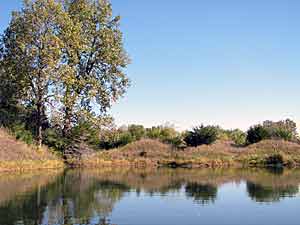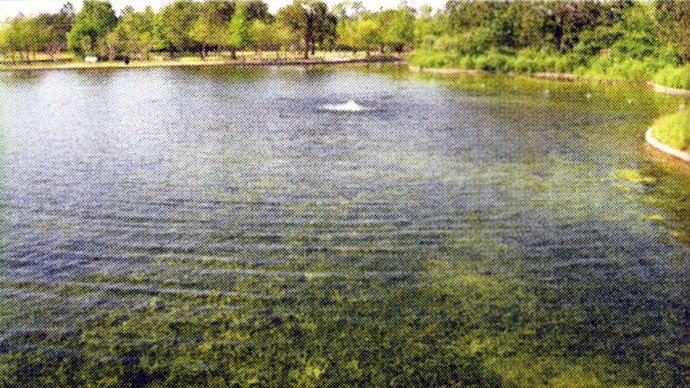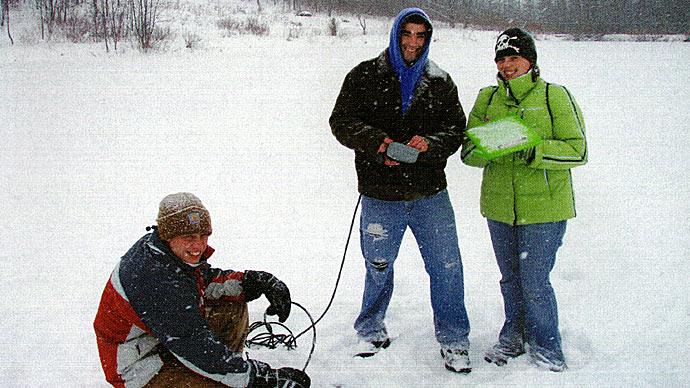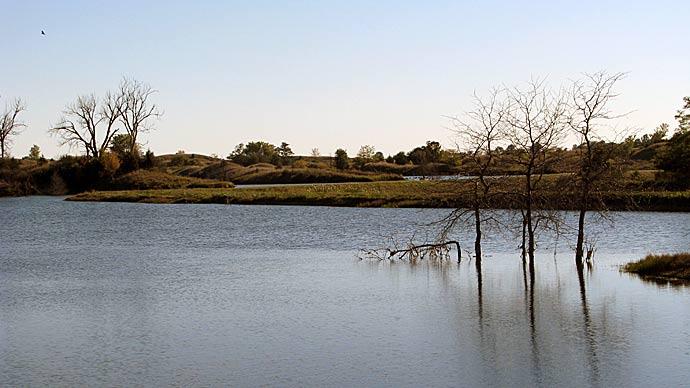
Old Man Winter has us in his grasp, so we switch gears, changing from backyard cookouts and summer vacations to football and hunting and family holidays. For some, it's time for ice skating and cross-country skiing. But pond management?
Right now, while you're knee-deep in dead leaves, your pond could be the last thing on your mind. Too bad.
Pond professionals know there is plenty to be done in the so-called "off-season," activities that will maintain or even enhance your fishery.
If you want to grow bigger fish in a healthier environment, roust yourself from the hearth. Your best summer of fishing could begin to take shape right now. Consider these off-season pond management tips:
Aeration
If you don't have an aerator system, consider installing one. For the pond owner on a tight budget, it might be the best money you can spend. If you have an aerator, keep it running.
Even though water's affinity for oxygen increases as water temperatures drop, consistent air supplies keep your pond's lifeblood flowing. Winter fish-kills are usually related to lack of oxygen.
Ponds, especially north of the Mason-Dixon Line, will freeze. That's not so bad, as long as sunshine makes it way through ice, to nurture plants and plankton in the depth. But, add a layer of snow, and things go dark under ice. When that happens, plants under ice consume oxygen. So do fish. Photosynthesis ceases. Without a source to replace it, oxygen levels drop, often below fatal limits. Dead fish.
Aeration helps manage oxygen levels in cold water. But, as Paul Harvey might say, "Here's the rest of the story."
Aerators move air or water. Those that move air, move water using air. If that sounds confusing, it shouldn't. An air compressor is installed, it pushes high volumes of air, low pressure, through a hose, to a manifold, or air stones, at the pond bottom. Millions of tiny bubbles cascade upward, trying to hold their breath, racing to the surface. Looks like a giant Alka-Seltzer tablet tossed in. Plop-plop, fizz-fizz. Fast moving bubbles also push water, from the bottom up.
A physics lesson is in order, here. Water is absolutely fascinating. H2O is most dense at 39 degrees F. Warmer water rises, but so does colder water. Think about it. Water freezes at 32 degrees, ice floats. During the winter, the "warmest" water lies at the bottom, colder water rises. That's why ponds don't freeze solid. That's also why aerators keep holes open in the ice during sub-freezing weather. Aerators push warmer water to the top.
Exercise caution, especially in the Midwest and north. Avoid placing your bottom aerators in the deepest water. Raise the manifold, or air stones. Keep them off the bottom, so not to disturb the warmest water in your pond this winter.
Fish habitat
Winter months provide ample opportunity to replace fish cover. Trees limbs, sans leaves, are easier to handle to create that "perfect" underwater honey hole for spring fishing.
This is more pleasant work during the winter — no bugs, no snakes, no boiling hot summer temps to steal a guy's motivation. Trim the lower limbs, put them in your boat, paddle to your favorite spot.
Tie the limbs loosely together with baling twine, anchor them with a concrete block, string tight enough to keep limbs in place and toss them overboard. By spring, limbs will be water-logged, in your favorite spot.
How much dead timber on the bottom is enough? Make a bundle that covers an area 6 feet by 6 feet by 6 feet. I recommend focusing these efforts in water no deeper than 10 feet. Stay away from the deepest parts.
On frozen ponds, adding cover is much easier. Wait till ice is thick enough to safely support the weight, then build your brush piles on top of ice, with concrete block tied to the branches. When the spring thaw arrives — presto-chango — it will sink itself.
Size is everything
When it comes to effectively managing your pond, especially with the use of fertilizers or aquatic herbicides, it's important to know the size of your pond. Do you know how much surface acreage your pond actually covers? Most people don't.
In my work, I find that people don't know how big their fish are, what size the pond is, or the depth of the water.
Three years ago, a client called to ask for prices on stocking a 30-acre take. I asked where the lake was located. He described the location, and it triggered my memory.
I had been to that lake, years before, and it was not a 30-acre lake. In fact, it was quite a bit smaller. When prodded, this new landowner told me the lake had been renovated, deepened, a new overflow pipe installed, but the overall size was the same as before. His 'dozer guys had assured him the lake was at least 30 acres.
The lake had been emptied during dirt work, then refilled with spring rains. Stocking a bass-bluegill fishery typically costs about $400 an acre, though it can be higher depending on the freight, distance, size of the fish we stock. In this case, starting over from scratch was going to cost $12,000, by the pond owner's math.
I suggested we measure it, just to be sure. He shrugged and agreed to the idea.
Feel free to use a measuring tape for this duty, or a distance wheel you see state troopers use at the scene of an auto accident. I prefer rangefinder glasses, often used by hunters and golfers, which can be purchased at your favorite sporting goods outlet for $200-to-$800.
With rangefinders, the landowner and I plotted and measured his lake at 18 acres. We calculated three times. Each time the numbers came to 18 acres. He was flabbergasted.
He was grateful. I could have sold the pond owner the number of fish for 30 acres as he requested. Instead, I stocked at densities appropriate for 18 acres, which saved the pond owner more than $6,000.
Here's a simple tip for the mathematically challenged: Take a sheet of graph paper, and plot a starting point. Then, using the rangefinders, shoot distances across the lake.
Using a draftsman's scale, like a three-sided ruler, plot those points on your graph paper. If each line of each square of your graph paper represents 50 feet, each square is 2,500 square feet. One acre is 43,560 square feet. Plot the distances, then connect the dots. You should see a rough map of your lake.
These days, many pond pros are taking advantage of the technology in global positioning systems (GPS). These devices bounce signals off orbiting satellites to allow the user to plot pond size, with stunning accuracy and detail.
This means a pond owner can precisely plot fish structure under water. Big deal? It could be.
Map the bottom
Accurately mapping structure on the lake bottom helps track fish movement and catch-rates. Find the best structure for your pond. With a GPS, you can duplicate it over the years in different parts of the pond.
Winter months are good time to map the lake bottom, using your depth finder, because summer vegetation has died away. Mats of thriving summer vegetation give false readings on your depth finder.
In a boat, drive slowly, straight across the lake. On graph paper, plot the water depth every 20-to-50 feet. Connect the similar depths. This will give your map the contour lines that will show you creek channels, drops and underwater humps. Draw them on your map, and those structures take shape.
Fish behavior
Make note of how and when your fish move and interact. Just because the day is cold doesn't mean fish won't move, or eat.
Cold blooded, fish have to adjust to their environment. Metabolism slows, movement slows, but neither stops during winter. Fish eat, but not as often. Remember just last summer, around the feeder? Your fish may have looked like angry piranha. Pond managers have learned to pull their feeders, once water temps drop below 55 degrees.
Often, feeders go into the workshop, to be cleaned and stowed until spring. Not so fast. Bluegill often will feed even when water temps dip into the lower 40's. I find this to be especially true of large, mature bluegill.
Some feeders in the south can keep bluegill nourished all winter. Watch your fish. They will tell you when to cut back on the rations, or when to stop all together.
Drawdown
If you had rooted aquatic vegetation this past year, winter might be the best time to deal with it, depending where you live. Some plants, not all, can be effectively managed by pulling the water down, exposing the greenery to frigid air temperatures and dry soils.
Winter drawdown is most effective where the ambient temp drops below freezing and stays there for several days at a stretch. Come spring, the water you released must be replaced, so drawdown may not be a viable technique if your pond is located in a drought-prone region.
Dirt work
In the Paul Bunyon country, land of the blue ox, most dirt construction works comes to a screeching halt when the ground freezes a foot or more below the surface. Not so in Dixie, where aggressive pond owners use the winter to get busy with heavy equipment.
Now's the time — before spring rains — to expand a pond, to rebuild a slough to attract migrating ducks and geese, to add depth, to cut peninsulas and other land features.
With some dirt crews, a pond owner can get more work done for the dollar, as roadwork and other projects go on hold until spring.
As you can see, just because all the morning doves and your favorite football team have gone south, and that big deer rack is on the wall, doesn't mean that your winter has been reduced to a recliner and remote control. There's plenty to do along the pond bank.
Okay, on those days when it's raining or snowing, and the wind is blowing by way of Saskatchewan, save a place for me in front of the TV for the big game. I'll bring the chips and dips.
Veteran fisheries biologist Bob Lusk runs Texoma Hatchery pond consulting service. He may be reached at 903-564-5372. His new book, "Raising Trophy Bass," may be purchased by calling 800-687-6075.
Reprinted with permission from Pond Boss Magazine



